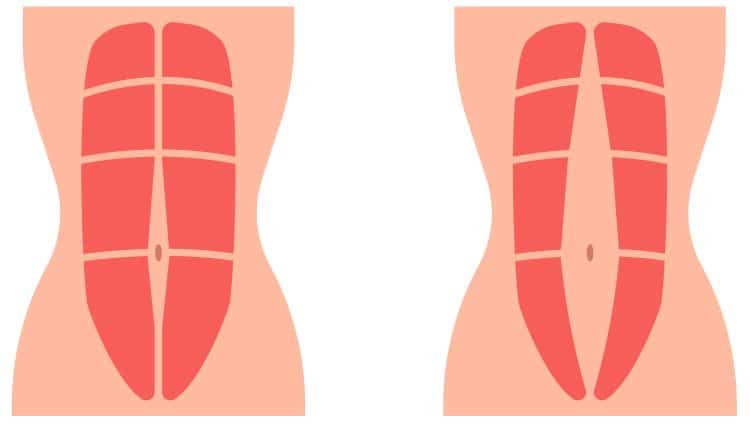During and after pregnancy, the abdominal muscles can stretch and separate down the middle, which is a condition called diastasis recti. Separated abdominals need to recover before you can return to regular abs exercises.
Almost everyone who exercises wants a flat, toned stomach. Some people dream of having washboard abs and a full-on six-pack. Besides improving your physique aesthetics, abs training can enhance core and lumbar spine stability and lower your risk of back pain.
As a veteran personal trainer with over 35 years in the industry, I’ve helped multiple women navigate diastasis recti. In this article, I share the 15 best exercises for overcoming this common condition.
Recent Updates: On June 5, 2024, Fitness Volt’s Senior Editor, Vidur Saini (American Council on Exercise-CPT), updated the article and added actionable expert tips throughout the piece to improve the reader experience.
Level Up Your Fitness: Join our 💪 strong community in Fitness Volt Newsletter. Get daily inspiration, expert-backed workouts, nutrition tips, the latest in strength sports, and the support you need to reach your goals. Subscribe for free!
Exercise Levels For Diastasis Recti
While you may be in a hurry to get your abs back after giving birth, it’s important to realize that doing too much too soon could delay your recovery rather than speed it up. As such, you need to return to training gradually.
The exercises in the following section are graded by difficulty, so you can choose the ones that best suit your needs and goals.
Level 1
These exercises are your foundation and must be mastered before moving to more advanced movements. The exercises in this section will help reeducate your abs and start gently bringing them back together as you build a basic level of strength.
You can start doing these exercises about four weeks after giving birth naturally or 12 weeks after a caesarian birth, provided you have the go-ahead from your healthcare professional.
Level 2
After 4-6 weeks of working on level one exercises, you should be ready to increase the intensity and duration of your abdominal workouts and progress to level two. However, only move up to level two if you have mastered the level one exercises and can perform them without discomfort. If in doubt, spend a little longer at level one to make sure you are ready to progress.
Level 3
Eight to 12 weeks after giving birth, and having trained your abs consistently during that time, you should be ready for level three. However, these exercises are considerably more demanding, so introduce them gradually, and don’t be afraid to backtrack to level two again if you find them a little too challenging.
15 Best Diastasis Recti Exercises
Here is the list of the best diastasis recti exercises for moms:
- Standing Ball Squeeze
- Tree Pose
- Wall Squats
- Sitting Single-Leg Raises
- C-Curving
- Sitting Leg Raises
- Transverse Abdominal Breathing
- Abdominal Bracing
- Posterior Pelvic Tilt
- Pelvic Tilts On Hands And Knees
- Cat And Cow Pose
- Modified Donkey Kicks
- Side-Lying Hip Abduction
- Clamshells
- Side Planks
3 Diastasis Recti Exercises While Standing
Standing exercises might seem overly easy, but they’re the best option for beginning ab training after giving birth. These exercises are very easy and low-risk. Still, they will gradually bring the sides of your abs back together.
1. Standing ball squeeze (Level: 1)
| Sets & Reps | 3 x 15-20 seconds |
| Target Muscles | Adductors (inner thigh muscles) |
This exercise is designed to reconnect you with your abs and gently start engaging them again. It’s also an excellent exercise for strengthening your adductors or inner thighs and stabilizing your hips.
How to do it:
- Place a soft ball between your knees, such as a yoga ball. Stand with your feet about hip-width apart. Bend your knees slightly for balance and stability.
- Lightly brace your abs, flattening them rather than pulling them in.
- Maintain your braced abs while gently pressing your knees together.
- Breathe normally throughout.
- Hold for 3-5 seconds, relax, and repeat.
Pro Tip: Pull your sit bones together while maintaining a neutral spine to maximize adductor activation and pelvic floor engagement.
2. Tree pose (Level: 1)
| Sets & Reps | Hold for 30-60 seconds per leg, 3 repetitions per leg |
| Target Muscles | Gluteus medius, gluteus minimus, core, balance muscles |
Tree pose is a gentle core exercise that’s also good for leg strength, balance, and mobility. This exercise is relatively easy, so you should find you can do it several times a day. It’ll also get easier with practice.
How to do it:
- Stand with your feet close together and your hands together in a prayer position in front of your chest.
- Brace your core, then pick up one foot and place it flat against the inside of the opposite knee.
- Make this exercise more challenging by raising your arms overhead into a “Y” position.
- Hold this position for time, and then swap legs and repeat.
Pro Tip: Press your lifted foot actively into your inner thigh for better balance and to challenge your core further.
3. Wall squats (Level: 1)
| Sets & Reps | 3 x 10-15 |
| Target Muscles | Quadriceps, hamstrings, gluteus maximus |
The wall squat might seem like an odd choice for an abs exercise, but doing it will teach you how to brace your abs as you generate force with your legs. It’s also a good way to tone and strengthen your lower body.
How to do it:
- Stand with your back to a smooth wall. Lean against it and place your feet a couple of feet in front of you. Gently brace your abs.
- Bend your knees and slide your back down the wall until your thighs are roughly parallel to the floor.
- Hold this position until you can feel fatigue building on your thighs. Do not hold your breath.
- Rest for a moment and then repeat.
Pro Tip: Shift your weight slightly towards your heels and push your knees outwards to maximize quadriceps recruitment.
3 Diastasis Recti Exercises While Sitting
You can also do the following seated abs exercises:
1. Sitting single leg raises (Level: 2)
| Sets & Reps | 3 x 10-15 per leg |
| Target Muscles | Rectus abdominis, hip flexors |
This simple exercise works your abs, hip flexors, and thighs. Done seated, you can pump out a few reps of this exercise during ad breaks while watching TV.
How to do it:
- Sit on the floor with your legs extended in front of you. Place your hands next to your hips for balance. Brace your abs.
- Keeping your leg straight, lift one leg as high as possible, maintaining the tension on your abs throughout.
- Lower your leg and repeat, aiming for 10-15 reps.
- Swap legs and repeat.
Pro Tip: Initiate the movement from your lower abdomen to prevent overusing your hip flexors. This subtle change biases the rectus abdominis.
2. C-curving (Level: 2)
| Sets & Reps | Hold for 30-60 seconds, 3 repetitions |
| Target Muscles | Rectus abdominis, obliques |
The C-curve is a modified abdominal crunch exercise from Pilates. The range of motion is small, and you use your arms for assistance and support, so it’s a suitable exercise for the latter stages of diastasis recti rehab. However, you should only do this exercise if your abdominal gap is down to two fingers or less.
How to do it:
- Sit on the floor with your legs bent and torso upright. With your arms outside your legs, hold onto the backs of your knees. Engage your abs.
- Leading with your lower back, roll your spine down toward the floor and lean back until your arms are straight.
- Using your arms as little as possible, curl yourself back up until your torso returns to upright.
- Do 5-10 slow, controlled reps.
Pro Tip: For a deeper stretch, round your upper back like a cat and reach your tailbone away.
3. Sitting leg raises (Level: 3)
| Sets & Reps | 3 x 10-15 |
| Target Muscles | Rectus abdominis, hip flexors |
This is a more challenging version of the single-leg raise exercise. Only attempt this once you have developed good abdominal strength and have mastered the single-legged version. Even then, it may be too demanding for some exercisers.
How to do it:
- Sit on the floor with your legs extended in front of you. Place your hands next to your hips for balance. Brace your abs.
- Keeping your knees straight, lift both legs off the floor, so you are balancing on your butt.
- Lower your legs and repeat.
- Make this exercise easier by moving your hands further back or harder by moving them forward.
Pro Tip: Anchor your hands under your glutes for support to prevent swinging and momentum.
3 Diastasis Recti Exercises on Your Back
Some of the best abdominal exercises are performed while lying on your back. While some of these moves are pretty challenging, if you’ve been working on your abs for a month or more, you should be ready for more demanding exercises. However, not all these exercises are complex, and some are ideal for beginners.
1. Transverse abdominal breathing (Level: 1)
This exercise is also known as diaphragmatic breathing. It teaches you to breathe into your abdomen, which engages your deep abdominal muscles. With practice, you can do this exercise anywhere and anytime, even while standing.
How to do it:
- Lie on your back with your legs bent and feet flat. Make sure your upper body is relaxed.
- Breathe into your abdomen so your belly swells outward. Monitor this by placing your hand on your stomach and watching it rise.
- Gently tense your abdominals and try to squeeze this “balloon” of air with your abs.
- Exhale, relax, and repeat.
Pro Tip: Imagine your breath filling your lower abdomen from back to front, like a balloon expanding in all directions.
2. Abdominal bracing (Level: 1)
Abdominal bracing is a more forceful version of transverse abdominal breathing. Instead of gently tensing your abdominals, you purposely engage them to create strong intra-abdominal pressure. Knowing how to brace and practicing it regularly will help bring your abdominals back together and also reduce your risk of developing lower back pain.
How to do it:
- Lie on your back with your legs bent and feet flat. Make sure your upper body is relaxed.
- Breathe into your abdomen so your belly swells outward.
- Pull up your pelvic floor like you are trying to stop the flow of urine, pull your abdominals inward, and tense your midsection like you are anticipating a blow to the stomach.
- Hold for five seconds, relax, breathe, and repeat.
Pro Tip: Combine bracing with a gentle pelvic floor lift (Kegel exercise) to integrate core and pelvic floor function for better stability and injury prevention.
3. Posterior pelvic tilt (Level: 1)
| Sets & Reps | Hold for 5-10 seconds, 10 repetitions |
| Target Muscles | Transverse abdominis, gluteus maximus |
This gentle diastasis recti exercise engages your lower abdominals and transverse abdominis, which run horizontally around your midsection. This muscle stabilizes your spine and minimizes lower back aches and pains.
How to do it:
- Lie on the floor with your legs bent and feet flat. Brace your abs.
- Contract your abdominals and tilt your pelvis up toward your sternum while simultaneously pressing your lower back into the floor.
- Relax and repeat 5-10 times.
Pro Tip: Initiate the tilt by gently drawing your lower abdominals in and up to engage the transverse abdominis and avoid overusing your hip flexors.
3 Diastasis Recti Exercises on Your Knees
Kneeling diastasis recti exercises vary from very easy to extremely intense. In all these exercises, you’ll have to use your abdominals to control your movements, stabilize your spine, and support the weight of your internal organs.
Level Up Your Fitness: Join our 💪 strong community in Fitness Volt Newsletter. Get daily inspiration, expert-backed workouts, nutrition tips, the latest in strength sports, and the support you need to reach your goals. Subscribe for free!
1. Pelvic tilts on hands and knees (Level: 1)
| Sets & Reps | 10-15 repetitions, 3 sets |
| Target Muscles | Core, pelvic floor muscles |
If lying pelvic tilts are too challenging for you right now, this is an exercise you can do instead. The movement is very similar, but there is much less resistance to overcome.
How to do it:
- Kneel on all fours so your shoulders are over your hands and your hips are over your knees. Adopt a neutral spine, i.e., slightly arched. Brace your abdominals.
- Tilt your pelvis and shorten the distance between your hips and your sternum. Your lower back should round slightly.
- Return to the neutral spine position and repeat.
- Do 10-20 controlled reps.
Pro Tip: As you tilt your pelvis forward, visualize lifting your pubic bone towards your belly button.
2. Cat and cow pose (Level: 1)
Cat and cow pose is an exercise from traditional yoga. Usually viewed as a lower back mobilizer, this is also an excellent exercise for gently engaging and stretching the abs. The cat and cow pose is a slight progression from kneeling pelvic tilts.
How to do it:
- Kneel on all fours so your shoulders are over your hands and your hips are over your knees. Adopt a neutral spine, i.e., slightly arched. Brace your abdominals.
- Shorten your abs and lift the middle of your back up toward the ceiling. Hold for 2-3 seconds.
- Next, contract your lower back muscles and pull your spine into a slightly hollowed position. Imagine you are trying to lower your abdomen to the floor. Again, hold for 2-3 seconds.
- Alternate between these two positions for 5-10 slow reps.
Pro Tip: Focus on a wave-like motion, starting the movement from your tailbone and allowing it to ripple up your spine.
3. Modified donkey kicks (Level: 1)
The donkey kick is usually viewed as a glute and lower back exercise. However, since you must brace your abs and stabilize your spine, these are a perfect diastasis recti exercise.
How to do it:
- Kneel on all fours so your shoulders are over your hands and your hips are over your knees. Adopt a neutral spine, i.e., slightly arched. Brace your abdominals.
- Keeping your leg bent, extend your hip and push your heel up toward the ceiling, taking care not to hyperextend your spine.
- Hold this position (but not your breath!) for 15-30 seconds.
- Swap sides and repeat.
Pro Tip: Externally rotate your leg slightly at the top of the kick to activate the deeper gluteal muscles.
3 Diastasis Recti Exercises on Your Sides
Side-lying exercises tend to work one side of your abs at a time and target your oblique or waist muscles. They help ensure that both sides of your abs are equally strong and that there are no left-to-right imbalances. So, make sure you always do the same number of reps on both sides!
1. Side-lying hip abduction (Level: 1)
| Sets & Reps | 3 x 10-15 per leg |
| Target Muscles | Gluteus medius, gluteus minimus |
Side-lying hip abduction, also known as side-lying leg raises, is a medial glute and outer thigh exercise that gently engages your abs and obliques. You’ll need to use these muscles to stabilize your hips and spine as you move your leg.
How to do it:
- Lie on your side with your legs straight and your hips and shoulders squared. Rest your head down on your outstretched upper arm. Engage your abs.
- Lift your uppermost leg off the floor and raise it to around 45 degrees. Point your toes slightly downward to increase glute activation.
- Lower your leg and repeat.
- Do 10-15 reps, roll over, and do the same number on the other side.
Pro Tip: Keep your toes pointed forward throughout the movement to prevent external rotation of the hip and ensure the gluteus medius is doing most of the work.
2. Clamshells (Level: 1)
| Sets & Reps | 3 x 15-20 per leg |
| Target Muscles | Gluteus medius, gluteus minimus |
Like side-lying hip abductions, clamshells work your glutes as much as your abs. Of course, that’s not bad, given that most people want flat abs and firm glutes! This exercise is so-called because it looks a little like a mollusk opening when you open your hips.
How to do it:
- Lie down on your side with your hips stacked and knees bent to 45 degrees.
- Rest your head on your upper arm and brace your core to stabilize your spine and pelvis.
- While keeping your feet together, lift and rotate your upper knee outward as high as possible without moving your hips or pelvis. Do not lean backward.
- Return to the starting position and repeat before rolling over and changing legs.
- Stop yourself from rolling backward by doing this exercise with your back and butt pressed against a wall.
Pro Tip: Don’t just open your knees; focus on rotating your top hip backward. It isolates the gluteus medius and prevents your lower back from arching.
3. Side Planks (Level: 2)
| Sets & Reps | Hold for 30-60 seconds per side, 3 repetitions per side |
| Target Muscles | Obliques, transverse abdominis, quadratus lumborum (QL) |
The side plank is a classic core and abdominal exercise that’s perfect for retraining your diastasis recti. However, it is quite challenging, so ensure you are comfortable with side-lying hip abductions before attempting this exercise.
How to do it:
- Lie on your side with your legs straight and your hips and shoulders squared. Support your upper body on your bent forearm. Engage your abs.
- Lift your hips, so your body forms a straight line.
- Hold this position for 10-30 seconds, and then relax.
- Roll over and repeat on the opposite side.
- You can make side planks easier by bending your legs and resting on the side of your knees instead of your feet.
Pro Tip: Stack your feet for an extra challenge and actively press your forearm into the ground to engage your shoulder stabilizers.
What is Diastasis Recti?
Diastasis recti affects the rectus abdominis muscle at the front of your abdomen. The rectus abdominis is a large, flat muscle that runs from your sternum and lower ribs down to your pelvis.
The rectus abdominis is divided into sections by lines of ligamentous tissue. There are horizontal lines and a vertical line down the middle. These lines are what give the abs their six-pack appearance, which becomes visible when your body fat is low enough.
During pregnancy, the baby grows and presses out against the inside of abdominal wall. Initially, the abs stretch to accommodate the increased size of the baby. This is possible because of a hormone called relaxin, which is produced during pregnancy.
However, in some cases, the abdominals will not only stretch but separate down the middle, along a line called the linea alba. Essentially, the linea alba “unzips” to provide more space for the growing baby.
This separation of the abdominals is called diastasis recti.
Once the mother has the baby, the edges of the abs will gradually come back together. However, they may not close completely. In most instances, the gap is left untreated, but sometimes it may be fixed surgically.
However, there are also exercises you can do that can help bring the sides of the abdominals closer together, if not completely back together. These exercises tighten and tone the abs, so they return to their original vertical position instead of lying open.
How Do I Test Myself for Diastasis Recti?
While it’s generally best not to try and diagnose medical conditions yourself, there is a quick and easy way to see if you have diastasis recti. Of course, you should also have this condition confirmed by a trained healthcare professional, who can also tell you the best course of action for treating it.
To determine if you have diastasis recti:
- Lie on the floor on your back with your knees bent and feet flat.
- Contract your abdominals and lift your head and shoulders slightly off the floor. Keeping one hand behind your head for support. Look down at your abdomen.
- Place your other hand above your belly button, palm down, and fingers pointing towards your feet.
- Use your fingers to gently probe for a gap between the edges of the abs.
- See how many fingers can fit in the gap between the two sides.
- If you feel a gap of two or more finger widths, report this to your healthcare provider.
- Repeat this test periodically to measure the improvements in your diastasis recti gap.
Why Does This Condition Need to Be Treated?
Separated abdominals are weak abdominals, and not treating diastasis recti can lead to long-term problems, including:
- Increased risk of lower back pain
- Pelvic and hip pain
- Urinary incontinence
- Constipation
- Pain during sex
- Body image issues
The good news is that there are exercises you can do to retrain your abdominals and bring them back together. However, it’s essential to understand that you cannot go back to intense abs training immediately after giving birth. Doing so could make things worse and lead to severe injury.
When Can You Start Working Your Abdominals After Pregnancy?
While it’s natural to want to return to exercise and “get your abs back” as soon as possible after giving birth, rushing into an intense workout program could do more harm than good. In most cases, you should wait four weeks after a natural birth and up to 12 weeks after giving birth by caesarian section.
However, your body doesn’t always run according to a strict schedule, so your personal circumstances may differ depending on how well you recover from giving birth.
As such, you should speak to your healthcare professional before embarking on any kind of workout program, including exercises for fixing diastasis recti.
Hold Up! Not All Workouts are Safe for Diastasis Recti
Diastasis recti usually responds well to abdominal reconditioning exercises. As the rectus abdominus strengthens and tightens, it will gradually pull itself back together. This may be a complete rejoining, or there may still be a narrow gap.
However, there are some exercises you should avoid while you heal your diastasis recti, as they can make things worse.
Exercises to avoid include anything that overloads your abs or make them bow outward. As such, you should avoid:
- Exercises with a pronounced twist, such as twisting crunches
- Sit-sups and crunches
- Full planks on elbows
- Downward dogs
- Double leg lifts (if done too soon)
- Lifting or carrying heavy weights
- High-impact exercises, such as running and jumping
- Any exercise that causes your abdominals to bulge, cone, or dome
Instead, focus on isometric or static exercises where you use your abdominals for bracing rather than producing movement. Once your diastasis recti gap is almost closed, you can start to gradually reintroduce sit-ups, crunches, etc., but only with the approval of your pregnancy health professional.
FAQs
How long after giving birth can I return to exercising?
In most cases, you can start exercising four weeks after a natural birth and 12 weeks after a caesarian delivery. However, you should always defer to your doctor, who may want you to hold off for longer, depending on how your pregnancy went.
While formalized exercise may have to wait for a few weeks, you can start being more active as soon as you feel able by going for progressively longer walks.
How soon will my diastasis recti heal?
Unfortunately, that’s an impossible question to answer as it depends on how wide the gap is, the condition of your abdominal muscles, and how much time and effort you are prepared to put into retraining your abs. It could take a few months, or a year or more.
The thing to remember that healing cannot be rushed and trying to put your own schedule on nature seldom works. So, do your exercises, be patient, and let healing happen naturally.
How often should I do diastasis recti exercises?
You can do some of the lower-intensity exercises pretty much every day. Still, as you start to get stronger and progress to the more challenging movements, every other day will be best, so your muscles get time to recover between workouts.
If your muscles feel sore or tired, that’s a good indicator you are doing too much, and should dial things back a little.
Final Thoughts
The body goes through some amazing changes during the three trimesters of pregnancy. There are hormonal, skeletal, postural, digestive, and muscular changes, all of which allow the fetus to grow and develop.
Needless to say, a developing baby takes up a lot of space, and while the abdomen does stretch, there is a limit to the elasticity of the abdominal muscles. And that’s where diastasis recti comes in. The abdominal muscles separate to accommodate the growing baby. Not all women experience diastasis recti but it’s very common.
The good news is that diastasis recti is not permanent, and the abdominal muscles usually come back together naturally over time. The 15 exercises explained in this article can help get the job done.
Finally, understand that diastasis recti is a medical condition and natural healing must be allowed to occur. Speak to your health care professional for advice on how best to treat this pregnancy-related issue.










